Can Antioxidants Support a Calmer Mood? What the Science Says
Introduction
Feeling “wired and tired,” mentally foggy, or emotionally on edge can have many causes—sleep, stress, nutrition, hormones, lived experiences, and more. One factor that’s easy to overlook is oxidative stress: the biochemical wear-and-tear on cells caused by an imbalance between reactive oxygen species (ROS) and the body’s antioxidant defenses.
Over the past two decades, research has linked oxidative stress and chronic, smoldering inflammation to mood challenges—anxiety, low mood, and stress reactivity. So the big question is: can antioxidants actually support a calmer mood? Short answer: they may help—especially as part of a broader, lifestyle-based approach. But there are nuances around what kind, how much, and for whom.
This guide breaks down the science into plain English, then gives you practical strategies—food, habits, and targeted supplements—to help your nervous system feel more resilient.
Looking for supplements for people with Social Anxiety? Click here.
🧪 Antioxidants 101: What They Do (and Why Your Brain Cares)
Antioxidants are molecules that donate electrons to neutralize ROS (free radicals), protecting lipids, proteins, DNA, and cell membranes from damage. Your body makes its own antioxidants (endogenous) and also borrows them from food (exogenous).
Key players:
- Endogenous: glutathione (GSH), superoxide dismutase (SOD), catalase, thioredoxin, CoQ10.
- Dietary: vitamin C, vitamin E, carotenoids (β-carotene, lutein), polyphenols (flavonoids, EGCG in green tea, curcumin in turmeric, resveratrol in grapes), selenium, zinc, alpha-lipoic acid (ALA), N-acetylcysteine (NAC).
Why the brain is vulnerable:
Your brain consumes ~20% of the body’s oxygen at rest, is rich in polyunsaturated fatty acids (easily oxidized), and depends on exquisitely tuned neurotransmitter pathways. Excess ROS can:
- Disrupt mitochondria (your neurons’ power plants), leading to low energy and “brain fog.”
- Oxidize membranes and receptors, affecting serotonin, dopamine, and GABA signaling.
- Trigger microglial activation (immune cells in the brain), contributing to neuroinflammation.
- Deplete BH4 (tetrahydrobiopterin), a cofactor needed to synthesize serotonin, dopamine, and norepinephrine—potentially altering mood chemistry.
Bottom line: stable redox balance supports calmer, clearer brain function.
🔥 Oxidative Stress, Inflammation, and the “Anxious Brain”

Think of oxidative stress and inflammation as background static that makes your stress circuits more trigger-happy. Here’s how that shows up:
HPA Axis Overdrive: Oxidative stress can keep your hypothalamic-pituitary-adrenal axis revving, elevating cortisol and heightening stress responses.
Neurotransmitter Flux: Oxidation of BH4 + nutrient deficits can reduce monoamine synthesis (serotonin/dopamine), correlating with low mood and heightened anxiety.
Neuroplasticity: Chronic oxidative stress can lower BDNF (brain-derived neurotrophic factor), which is important for learning, emotional flexibility, and resilience.
Does reducing oxidative stress cause calmer mood? In some people, it may—especially if diet and lifestyle are major contributors to the redox “noise.” For others, antioxidants are supportive but not sufficient without sleep, therapy, stress skills, and movement.
🧭 The Evidence in Plain English: What Studies Generally Find
Dietary patterns rich in antioxidants—Mediterranean-style diets emphasizing vegetables, fruits, legumes, whole grains, olive oil, nuts, seeds, and fish—consistently associate with better mood and lower anxiety compared to ultra-processed patterns.
Polyphenol-rich foods (berries, cocoa, green tea) and carotenoids correlate with markers of lower oxidative stress and improved cognitive performance; mood signals often track in the same direction.
N-acetylcysteine (NAC), a glutathione precursor, has shown promise in clinical research across stress-linked conditions (results vary by population), suggesting redox support can influence emotional regulation for some.
Omega-3s (not classic antioxidants, but anti-inflammatory) frequently improve mood/anxiety metrics—reducing the inflammatory inputs that fuel oxidative stress.
Vitamin C supplementation can acutely lower perceived stress in some scenarios (e.g., exam stress), likely via adrenal and redox effects.
CoQ10 and ALA support mitochondrial function; small trials and mechanistic data suggest potential benefits for fatigue, stress tolerance, and cognition.
Caveat: Evidence is heterogeneous—different doses, durations, and populations. Antioxidants are helpers, not silver bullets.
⚖️ The Hormesis Principle: Why “More” Isn’t Always Better
A key nuance: the hormesis concept. Small, intermittent “stressors” (exercise, polyphenol-rich plants, heat/cold exposure) upregulate your body’s own antioxidant defenses via Nrf2 and related pathways. In contrast, chronic, very high doses of isolated antioxidant pills could theoretically blunt beneficial adaptations in some contexts (e.g., heavy vitamin C/E around training might limit fitness gains in certain studies).
Practical takeaway:
- Prefer food-first antioxidant strategies and moderate supplemental doses.
- Use targeted supplementation (when appropriate) rather than megadosing everything.
🥗 Food-First Framework: Building a Calming, Antioxidant-Forward Plate
🌈 Eat the (Deep) Rainbow
Aim for 8–12 servings of plants daily (fruits/veg/legumes), prioritizing deep pigments: blueberries, blackberries, cherries, pomegranates, red cabbage, beetroot, spinach/kale, carrots, pumpkin, tomatoes.
Mood-friendly picks:
- Berries 🫐: anthocyanins support vascular and neuronal health.
- Leafy greens 🥬: magnesium, folate, vitamin K, carotenoids.
- Citrus/kiwi 🍊🥝: vitamin C for adrenal and immune support.
- Tomatoes 🍅: lycopene (especially when cooked with olive oil).
- Cocoa 🍫 (70%+): flavanols (keep portions modest).
🫒 Quality Fats to Tame Inflammation
- Extra-virgin olive oil (polyphenols)
- Nuts & seeds (walnuts, almonds, pumpkin, chia, flax)
- Fatty fish (salmon, sardines, mackerel) or algae oil for DHA/EPA
🌾 Smart Carbs, Steady Mood
Whole grains and pulses (oats, quinoa, lentils, beans) stabilize blood sugar (preventing cortisol spikes that feel like anxiety) while delivering polyphenols and fiber for your microbiome.
🦠 Feed Your Gut (So It Feeds Your Brain)
- Ferments: kefir, yogurt, kimchi, sauerkraut, miso, tempeh
- Prebiotics: garlic, onions, leeks, asparagus, green bananas, oats
Your microbiota produce short-chain fatty acids (SCFAs) that lower inflammation and support the gut-brain axis.
🧴 Targeted Antioxidant Supplements: What’s Commonly Used (and Why)
Important: Supplements aren’t a replacement for medical care. Talk to your clinician—especially if pregnant, nursing, medicated, or managing health conditions.
🍊 Vitamin C (ascorbic acid)
Role: Water-soluble antioxidant; supports adrenal function; regenerates vitamin E; cofactor in neurotransmitter synthesis and collagen.
Typical range: 250–1,000 mg/day (in divided doses).
Notes: High doses can cause GI upset; food sources still matter.
🥜 Vitamin E (mixed tocopherols/tocotrienols)
Role: Lipid membrane protection (fat-soluble).
Typical range: 100–200 IU/day if supplementing.
Cautions: Very high doses may increase bleeding risk or interact with anticoagulants; prioritize food (nuts, seeds, EVOO).
🧪 N-Acetylcysteine (NAC)
Role: Cysteine donor → glutathione synthesis; redox + detox support.
Typical range: 600–1,200 mg/day (sometimes more under supervision).
Notes: Can be stimulating for a few; take earlier in the day if sensitive.
⚡ Alpha-Lipoic Acid (ALA)
Role: Versatile antioxidant (water + fat soluble); mitochondrial cofactor; may aid glucose/insulin balance (stable energy = calmer mood).
Typical range: 200–600 mg/day.
Notes: Take away from minerals; monitor for hypoglycemia if on glucose-lowering meds.
🔋 Coenzyme Q10 (Ubiquinone/Ubiquinol)
Role: Mitochondrial electron transport; antioxidant in membranes/lipoproteins.
Typical range: 100–200 mg/day (ubiquinol often better absorbed).
Notes: Fat-containing meals improve absorption.
🧬 Selenium + Zinc
Role: Cofactors for antioxidant enzymes (glutathione peroxidases; SOD).
Typical range: Selenium 50–200 mcg/day; Zinc 10–25 mg/day short term if deficient.
Notes: Don’t megadose; both can be harmful at high levels. Balance zinc with copper if used long term.
🌿 Polyphenol Concentrates
Green tea (EGCG), curcumin, grape seed extract, resveratrol
Role: Indirect antioxidant via Nrf2 activation; anti-inflammatory signaling.
Notes: Curcumin needs piperine or liposomal/phytosomal forms for bioavailability; EGCG with caution if sensitive to caffeine (decaf or isolated EGCG is an option).
🧠 Omega-3s (EPA/DHA)
Role: Anti-inflammatory, membrane fluidity, neurotransmission support.
Typical range: 1,000–2,000 mg/day combined EPA+DHA (often EPA-leaning for mood).
Notes: Not an antioxidant, but synergistic—reduces inflammatory drivers of oxidative stress.
Strategy tip: Start with one or two evidence-supported additions (e.g., vitamin C + omega-3, or NAC + magnesium glycinate) and track mood/sleep/stress for 2–4 weeks before layering more.
Looking for supplements for people with Social Anxiety? Click here.
🌬️ Breathwork, Movement, and Sleep: Amplifiers for Antioxidant Benefits

Antioxidants reduce “background static.” These habits turn down the volume of stress in real time and upgrade your body’s own defenses.
🌬️ Breathwork to Nudge the Nervous System
Extended exhale breathing: Inhale 4, exhale 6–8 (vagus activation, lower heart rate).
Resonance breathing: ~6 breaths/min (e.g., 5s in/5s out) to improve HRV and calm reactivity.
Box breathing: 4–4–4–4 for focus + steadiness pre-meeting or social event.
These practices reduce cortisol and can improve gut motility and digestion—tightening the gut-brain loop.
Want to try Breathwork? Click Here.
🏃 Movement as “Antioxidant Training”
Regular aerobic + strength exercise increases endogenous antioxidant enzymes (SOD, catalase) and boosts mitochondrial biogenesis (more efficient energy = less oxidative stress for each unit of work).
Aim for 150–300 minutes/week of moderate movement + 2 days of strength.
Include easy zone 2 cardio and walks outdoors for light + mood synergy.
😴 Sleep: Your Overnight Redox Reset
Deep, consistent sleep is when the brain clears metabolic by-products (glymphatic system) and resets inflammatory signals.
Protect a 7–9 hour window.
Wind-down 60–90 minutes pre-bed (dim light, screens low-blue, chamomile tea, magnesium glycinate if appropriate).
Keep the room cool, dark, and quiet.
🍽️ One-Week “Calmer Mood” Menu Sketch (Food-First)
Day 1 Example
- Breakfast: Steel-cut oats with blueberries, chia, walnuts; green tea.
- Lunch: Quinoa bowl with kale, roasted salmon, avocado, EVOO-lemon dressing.
- Snack: Kefir yogurt with cinnamon + cocoa nibs.
- Dinner: Lentil-veggie chili with tomatoes, peppers, onions; side salad.
Day 2 Example
- Breakfast: Greek yogurt parfait (strawberries + pumpkin seeds); kiwi on the side.
- Lunch: Chickpea, spinach & tomato stew; whole-grain pita; olive tapenade.
- Snack: Apple + almond butter.
- Dinner: Sardines on whole-grain toast with arugula; beet-citrus salad.
Repeat the pattern with variety: berries daily, leafy greens 1–2×/day, ferment 1×/day, color at every meal, fish 2–3×/week (or algae oil supplement).
🧩 Troubleshooting Guide: “I Tried Antioxidants and Don’t Feel Different”
Check foundations first: Sleep, protein intake, hydration, and fiber.
Simplify the stack: Too many supplements at once can mask what’s helping.
Time horizon: Many benefits accrue over 4–12 weeks of consistent eating and habits.
Dose/form: Curcumin bioavailability? CoQ10 ubiquinol? NAC timing? These details matter.
Interactions: If you’re on medications (e.g., anticoagulants, SSRIs, thyroid meds), get professional guidance.
🚫 Common Pitfalls & Safety Notes
- Mega-dosing fat-soluble antioxidants (E, A, high β-carotene in smokers) can be counterproductive or risky.
- “Detox” overload: Adding multiple redox-active supplements at once may cause headaches, GI upset, or jitteriness in sensitive folks.
- Green tea extracts at high doses: rare liver stress in predisposed individuals—follow label guidance and quality sourcing.
- NAC + certain meds: discuss with your clinician.
Rule of thumb: If it’s giving you side effects, back down and simplify.
🧑⚕️ Where Therapy and Antioxidants Meet
Nutrition helps lower the biochemical barriers to feeling calm. Therapy builds skills and perspective for real-world situations. Both matter.
- CBT/ACT/exposure therapy: Rewire anxious patterns and avoidance behaviors.
- Somatic therapies: Teach your body safety (useful when stress lives “below the neck”).
- Group support: Social learning and graded exposure in a safe context.
Many people experience the biggest shift when dietary upgrades + breathwork + therapy + movement + sleep all work together.
Looking for online therapy for people with Social Anxiety? Click Here.
✅ Quick-Start Blueprint (TL;DR)
Plant-rich Mediterranean pattern (deep colors + ferments + nuts/seeds + EVOO + fish/algae).
Hydrate and prioritize protein (feel steady, avoid blood sugar dips).
Consider one targeted supplement from each category (with guidance):
- Redox: Vitamin C or NAC.
- Mito: CoQ10 or ALA.
- Inflammation: Omega-3 (EPA/DHA).
Breathe daily (5 minutes resonance breathing) + move most days.
Defend sleep like it’s your job.
Layer therapy if anxiety meaningfully impairs life.
🎯 Final Thoughts
So—can antioxidants support a calmer mood?
For many people, yes—indirectly but meaningfully. Through nutrition patterns, polyphenol-rich plants, and targeted support (like vitamin C, NAC, CoQ10, ALA, omega-3s), you can reduce oxidative “static,” ease neuroinflammatory signaling, and give your neurotransmitters and mitochondria conditions to thrive.
But think synergy, not magic bullets. Antioxidants are one gear in a larger machine that includes sleep, breathwork, therapy, movement, sunlight, and community. Put those pieces together, and your nervous system gets the message: it’s safe to calm down.
Looking for supplements for people with Social Anxiety? Click here.
📚 References & Further Reading (select, accessible starting points)
Diet & Mood: Jacka FN et al. BMC Medicine (2017) – dietary improvement and depression; Mediterranean pattern research overviews.
Oxidative Stress & Anxiety: Salim S. J Neurosci Res – oxidative stress and anxiety pathophysiology (review).
NAC & Redox: Berk M. et al. Neurosci Biobehav Rev – NAC in psychiatry (review).
Polyphenols & Brain: Spencer JPE. Proc Nutr Soc – polyphenols, cognition, and neuroinflammation.
Omega-3s & Mood/Anxiety: Su K-P. et al. JAMA Psychiatry (meta-analysis).
Hormesis & Antioxidants: Ristow M., Schmeisser K. EMBO Rep – hormesis and adaptive stress responses.
(Note: These are representative resources; individual results vary and professional advice is recommended.)
Related Posts
-

Supplements for Staying Present and Grounded
L-Theanine is nature’s calm focus enhancer 🍃. Derived from green tea, it promotes relaxation without drowsiness by balancing GABA, serotonin, and dopamine. Learn how this amino acid supports smooth focus, emotional balance, and mindful presence in daily life.
-
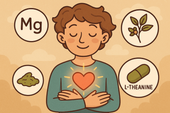
Supplements That Support Emotional Openness
Emotional openness starts in the body 🌿. When your nervous system feels safe, your heart can express freely. Learn how supplements like magnesium, Ashwagandha, and L-theanine support calm connection, balanced emotions, and the courage to stay authentically open.
-
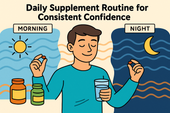
Daily Supplement Routine for Consistent Confidence
Confidence is built through rhythm, not luck 🌿. A daily supplement routine can help your energy, mood, and focus stay balanced from morning to night. Learn how adaptogens, magnesium, and B vitamins work together to create steady calm and lasting self-assurance.
-
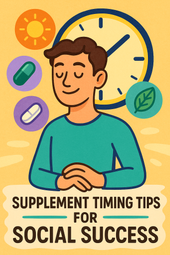
Supplement Timing Tips for Social Success
Social confidence has its own rhythm 🌿. When you time your supplements to match your body’s natural energy cycles, calm and focus align effortlessly. Learn how magnesium, L-theanine, and adaptogens can help you stay grounded, charismatic, and fully present at just the right moment.
-
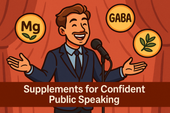
Supplements for Confident Public Speaking
Public speaking confidence begins with biology 🎤🌿. When your nervous system is calm and your neurotransmitters are balanced, your voice, focus, and presence flow naturally. Learn how supplements like magnesium, GABA, and adaptogens can align your body’s chemistry with the calm clarity you need to speak authentically.
-

Travel-Friendly Supplements for On-the-Go Confidence
Magnesium is the ultimate travel mineral for calm and balance ✈️🌿. It relaxes the nervous system, eases stress from jet lag or fatigue, and supports muscle and mental recovery. Discover how this essential nutrient keeps you centered, focused, and energized wherever your journey takes you.
-

Supplements for Confident Video Calls
Magnesium is the mineral that brings calm to both body and mind 🌿. It supports relaxation, better sleep, and a stable mood by regulating cortisol and soothing the nervous system. Learn how magnesium supplements can restore balance, reduce anxiety, and help you feel centered under stress.
-

Ashwagandha for Calming the Stress Response
Ashwagandha helps your body remember how to relax 🌿. As one of the most trusted adaptogens, it calms the stress response by lowering cortisol, soothing the nervous system, and restoring natural energy balance. Learn how this ancient herb promotes deeper sleep, emotional steadiness, and resilience in today’s high-stress world.
-
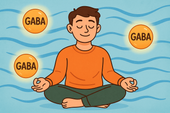
How GABA Supplements Can Help You Feel Grounded
GABA is the brain’s natural calm signal 🌿. When life feels overwhelming, this neurotransmitter helps quiet mental noise, relax muscles, and restore emotional balance. Learn how GABA supplements can calm the nervous system, reduce anxiety, and help you feel grounded in your body again.
-
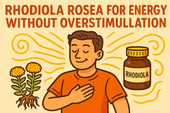
Rhodiola Rosea for Energy Without Overstimulation
Rhodiola rosea offers a rare kind of energy — one rooted in calm, not chaos 🌿. Known as the golden root, this adaptogen enhances endurance, focus, and mood by balancing cortisol and supporting the nervous system. Discover how Rhodiola restores natural vitality without the overstimulation of caffeine or stress-driven fatigue.
-
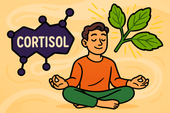
Holy Basil and Cortisol Control
Holy basil, or Tulsi, is one of nature’s most powerful adaptogens 🌿. Revered in Ayurvedic medicine for centuries, it helps balance cortisol, calm the mind, and protect the body from stress. Learn how holy basil restores hormonal harmony, supports energy, and promotes emotional resilience in a fast-paced world.
-
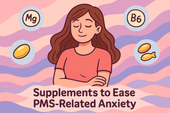
Supplements to Ease PMS-Related Anxiety
Hormones are the body’s messengers — guiding mood, energy, metabolism, and balance. 🌿 When these chemical signals flow in harmony, life feels stable and calm. Learn how nutrients, sleep, and stress management help keep hormonal communication clear, supporting emotional steadiness and overall vitality.
-
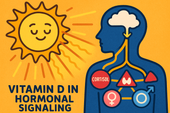
The Role of Vitamin D in Hormonal Signaling
Testosterone is more than a hormone — it’s a signal of strength, motivation, and vitality 💪. Learn how this key molecule shapes energy, mood, muscle growth, and focus in both men and women. Discover how nutrition, vitamin D, and minerals like zinc and magnesium support healthy testosterone signaling for balanced power and performance.
-
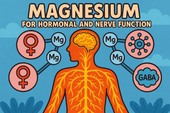
Magnesium for Hormonal and Nerve Function
Magnesium is the mineral that connects calm and vitality ⚡. It fuels nerve transmission, supports hormonal balance, and restores the body’s ability to relax under stress. Learn how magnesium strengthens communication between the nervous and endocrine systems, stabilizing cortisol, thyroid, and reproductive hormones for true equilibrium.
-

Zinc and Its Role in Hormonal Stability
Zinc is one of the body’s most powerful regulators ⚖️—a trace mineral that keeps hormones, metabolism, and energy in perfect rhythm. Learn how zinc supports testosterone, thyroid function, cortisol balance, and emotional stability while protecting against modern stress and deficiency. Discover why restoring zinc can help your body feel grounded, focused, and hormonally resilient.
-
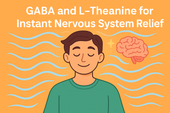
GABA and L-Theanine for Instant Nervous System Relief
When stress hits, your nervous system needs relief — not more stimulation 🌿. Discover how GABA and L-theanine work together to calm the body, quiet racing thoughts, and restore inner balance. Learn the science behind these natural compounds that ease tension, support emotional stability, and bring instant peace without sedation.
-
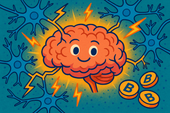
B-Vitamins for Faster Nerve Communication
Vitamin B1, or thiamine, is your brain’s ignition key 🔑—turning food into cellular energy and powering rapid nerve signaling. Discover how this essential nutrient fuels neurotransmitter activity, supports focus and coordination, and prevents fatigue or mental fog. Learn why maintaining optimal thiamine levels keeps your nerves firing fast and your mind sharp.
-

Supplements That Help You Stay Alert Without Anxiety
L-theanine is nature’s secret for calm focus and balanced energy 🌿. Found in green tea, this gentle amino acid promotes relaxation, supports alpha brain waves, and helps you stay alert without stress or grogginess. Discover how L-theanine can enhance focus, improve sleep quality, and restore mental calm in a fast-paced world.
-
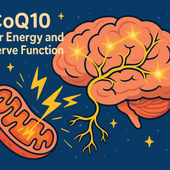
CoQ10 for Energy and Nerve Function
CoQ10 powers every cell in your body—from your heart to your brain ⚡. Learn how this essential compound fuels mitochondria, boosts nerve function, and protects your brain from oxidative stress. Discover how supplementing with CoQ10 can restore energy, sharpen focus, and support long-term neurological vitality.
-
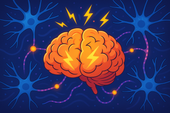
Supplements That Support Nerve Signaling for Mental Energy
Your brain’s electrical network depends on magnesium—one of the most vital minerals for nerve signaling, calm focus, and steady mental energy ⚡. Learn how this essential nutrient powers neurotransmission, supports relaxation, and helps protect your nervous system from stress overload—so your mind feels balanced, alert, and resilient every day.
-
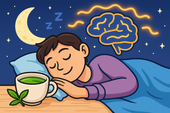
L-Theanine for Sleep Without Grogginess
L-theanine offers a natural path to better sleep—without the next-day fog. 🌙 Found in green tea, this gentle amino acid calms the mind, lowers stress hormones, and promotes deep relaxation without sedation. Learn how L-theanine balances your brainwaves, reduces nighttime anxiety, and helps you wake up refreshed, alert, and clear-minded.
-
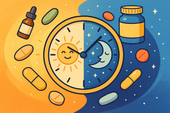
Supplements to Support the Circadian Rhythm
Your body’s natural clock depends on more than just sunlight—it also relies on key nutrients to stay in sync. 🌞🌙 Discover the best supplements to support your circadian rhythm, from melatonin and magnesium for deep sleep to vitamin D and adaptogens for morning energy. Learn how to realign your internal clock for better rest, sharper focus, and stable mood every day.
-
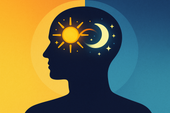
Melatonin and Cortisol: The Night vs. Day Hormones
Melatonin and cortisol are your body’s night-and-day hormones—one helping you drift into deep sleep, the other powering your alertness each morning. 🌙☀️ Learn how these two forces work together to regulate your energy, mood, and recovery. Discover how modern stress, artificial light, and poor routines can throw them off balance—and how to naturally reset your rhythm for calm nights and focused days.
-
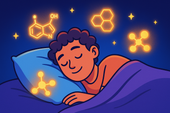
Supplements for Deeper Sleep and Nervous System Reset
Struggling to sleep even when you’re exhausted? 🌙 Discover how to reset your nervous system and achieve deeper, more restorative rest with the right blend of supplements, breathwork, and therapy. From magnesium and L-theanine to slow exhalations and somatic healing, this guide helps you rebuild your body’s natural rhythm of calm and recovery—so you can wake up truly renewed.
-
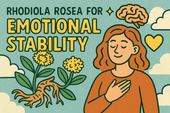
Rhodiola Rosea for Emotional Stability: Finding Balance Through Resilience
Stress is the body’s natural alarm system — useful in bursts, but draining when it never turns off. Learning to regulate it helps restore calm focus, emotional balance, and physical vitality. 🌿💫
-
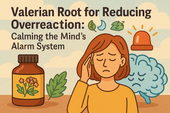
Valerian Root for Reducing Overreaction: Calming the Mind’s Alarm System
GABA is the brain’s natural brake pedal — calming overstimulation and helping you think clearly under stress. When balanced, it brings a sense of inner peace, emotional control, and focus. 🌿🧠💫
-

Supporting Adrenal Health for a Steadier Mood
Cortisol is the body’s built-in stress alarm — essential in short bursts but harmful when constantly elevated. Learning to balance it naturally restores calm, focus, and emotional stability. 🌿⚖️
-
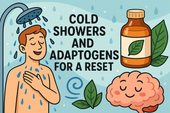
Cold Showers and Adaptogens for a Reset: Reclaiming Energy, Calm, and Control
Adaptogens help the body adapt to stress, restoring calm energy and balance. These ancient herbs strengthen resilience, regulate mood, and support focus — helping you stay grounded through life’s ups and downs. 🌿💫
-
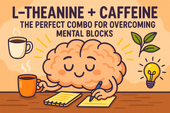
L-Theanine + Caffeine: The Perfect Combo for Overcoming Mental Blocks
Neurotransmitters are the brain’s messengers — tiny molecules that shape how we think, feel, and focus. When they’re in balance, we experience calm energy, clear thinking, and emotional harmony. 🌿🧠✨
-
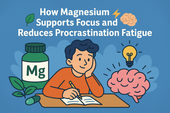
How Magnesium Supports Focus and Reduces Procrastination Fatigue
Magnesium is the quiet mineral behind mental clarity and steady focus. By calming the nervous system and restoring cellular energy, it helps transform fatigue and overthinking into calm, productive flow. 🌿⚡🧠
-

B Vitamins for Beating Procrastination and Boosting Energy
Procrastination isn’t just a mindset — it’s often a signal of low energy and nutrient depletion. B vitamins recharge the brain’s motivation circuits, boosting focus, clarity, and the drive to take action. 🌿⚡🧠
-
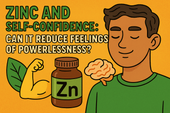
Zinc and Self-Confidence: Can It Reduce Feelings of Powerlessness?
Zinc isn’t just a mineral — it’s the foundation of emotional strength. By balancing neurotransmitters and calming the nervous system, it helps you feel more centered, assertive, and confident from the inside out. 🌿💪
-
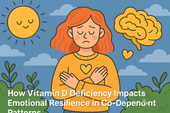
How Vitamin D Deficiency Impacts Emotional Resilience in Co-Dependent Patterns
Co-dependency is the emotional tug-of-war between connection and self-loss — a pattern born from giving too much and receiving too little. Learning to untangle this dynamic allows for real love rooted in balance, not fear. 🌿💛
-
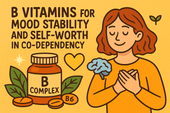
B Vitamins for Mood Stability and Self-Worth in Co-Dependency
Vitamin B1, or thiamine, powers both the body and the brain — fueling focus, energy, and emotional clarity. Supporting your nervous system with this essential nutrient helps restore calm and mental resilience. 🌿⚡🧠
-
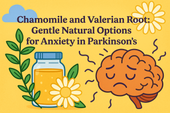
Chamomile and Valerian Root: Gentle Natural Options for Anxiety in Parkinson’s
Anxiety often feels like a storm inside the mind — racing thoughts, tightness, and unease that make it hard to focus or rest. But learning to understand and calm that inner storm opens the door to peace and emotional balance. 🌿🧠
-
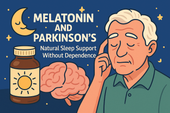
Melatonin and Parkinson’s: Natural Sleep Support Without Dependence
Melatonin is the body’s natural sleep hormone — guiding your mind into rest and your body into recovery. Supporting its natural rhythm can improve sleep quality, mood, and overall health without dependence. 🌙🧠
-
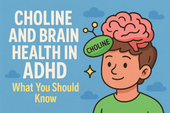
Choline and Brain Health in ADHD: What You Should Know
Inflammation can quietly affect both the body and mind, disrupting focus, mood, and energy. Understanding how it works — and how to calm it — is key to restoring balance, clarity, and long-term health. 🌿🧠
-
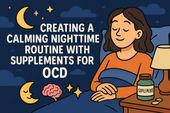
Creating a Calming Nighttime Routine with Supplements for OCD
Sleep is the brain’s nightly repair ritual — a time when emotional chaos settles and clarity returns. Prioritizing deep rest restores focus, calm, and resilience, helping both the body and mind recover naturally. 🌙🧠
-
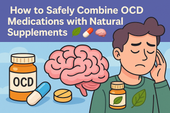
How to Safely Combine OCD Medications with Natural Supplements
Supplements bridge the gap between nutrition and mental wellness — supporting focus, calm, and energy from within. The right combination of nutrients can help balance mood, sharpen the mind, and restore long-term resilience. 🌿🧠
-
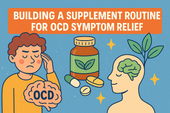
Building a Supplement Routine for OCD Symptom Relief
OCD can feel like being trapped in your own thoughts — a battle between control and chaos. Understanding the science behind these cycles is the first step toward breaking free and finding calm within the mind. 🌿🧠
-

Curcumin and Brain Inflammation in OCD: Can It Help?
Inflammation doesn’t just affect the body — it can silently influence the brain, fueling anxiety, fatigue, and mental fog. By understanding how inflammation works, we can learn how to calm the nervous system and restore inner balance. 🌿🧠
-
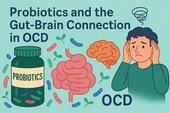
Probiotics and the Gut-Brain Connection in OCD
Serotonin, often called the “feel-good” chemical, shapes our mood, focus, and emotional balance. By keeping this neurotransmitter in harmony, we support calm thinking, better sleep, and greater mental resilience. 🌿🧠
-

B Vitamins and OCD: Supporting Energy and Neurotransmitter Balance
OCD isn’t just about habits — it’s about the brain’s struggle to find control in chaos. Understanding the neurological roots behind intrusive thoughts can help replace fear with clarity and guide healing toward calm awareness. 🌿🧠
-
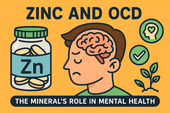
Zinc and OCD: The Mineral’s Role in Mental Health
Zinc is more than a trace mineral — it’s a key regulator of mood, memory, and emotional balance. By stabilizing neurotransmitters like serotonin and glutamate, zinc helps calm obsessive thought patterns and supports overall mental clarity. 🌿🧠
-
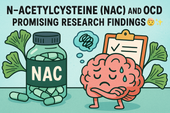
N-Acetylcysteine (NAC) and OCD: Promising Research Findings
Antioxidants act as the body’s natural defense system, neutralizing free radicals that damage brain cells and worsen anxiety or fatigue. Supporting antioxidant balance with nutrition and supplements helps protect focus, memory, and emotional stability. 🌿🧠
-
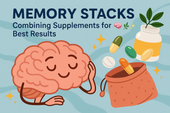
Memory Stacks: Combining Supplements for Best Results
Memory weaves the story of who we are — connecting past, present, and future through every experience we store and recall. Strengthening memory means nurturing the brain’s energy, balance, and emotional calm so learning becomes effortless. 🌿🧠
-
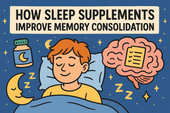
How Sleep Supplements Improve Memory Consolidation
Stress can cloud thinking, disrupt sleep, and weaken memory — but understanding its effects on the brain is the first step toward calm. By learning to regulate the nervous system, we can protect focus, energy, and emotional balance. 🌿🧠
-
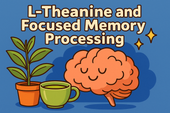
L-Theanine and Focused Memory Processing
Science is the art of curiosity and precision — a quest to understand the unseen patterns that shape life. From molecules to galaxies, every discovery begins with observation, imagination, and the courage to ask “why.” 🔬💡
-
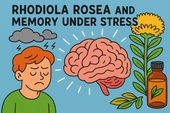
Rhodiola Rosea and Memory Under Stress
Stress clouds memory, slows thinking, and drains energy — but the good news is, the brain can recover. By understanding how stress affects focus and emotion, we can learn to regulate it, restore clarity, and protect long-term cognitive health. 🌿🧠
-
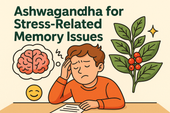
Ashwagandha for Stress-Related Memory Issues
Adaptogens are nature’s answer to modern stress. These powerful herbs — like Ashwagandha, Rhodiola, and Holy Basil — help balance cortisol, support calm focus, and strengthen the body’s resilience, bringing the mind back to harmony. 🌿🧘♀️


















































